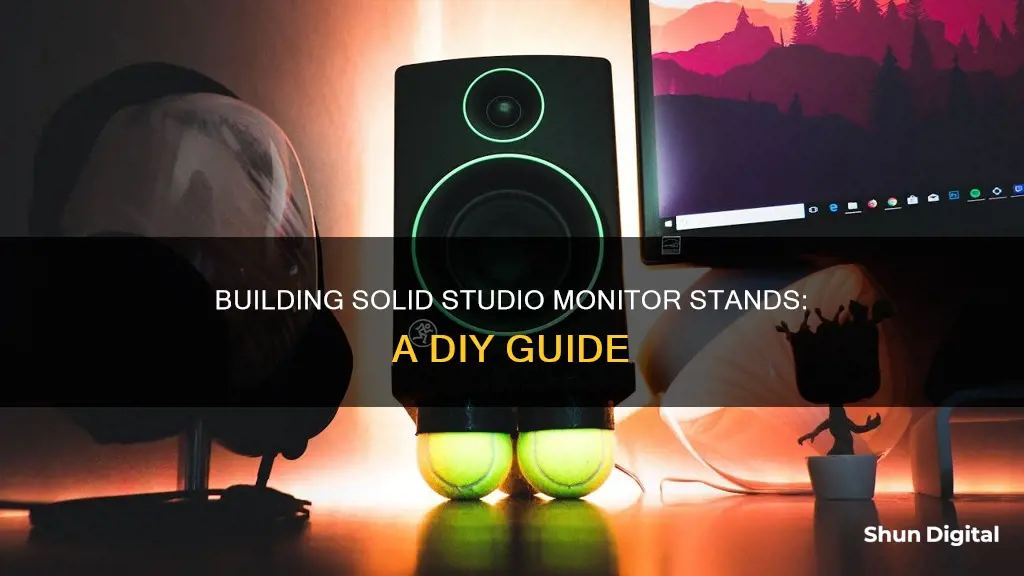
Studio monitor stands are an essential part of any recording setup, ensuring that your speakers are at the optimal height and angle for the best sound output. While you can buy pre-made stands, building your own is a more affordable option and allows you to customise the height and design to your specific needs. This introductory guide will take you through the process of building your own studio monitor stands, covering the materials needed, the benefits of DIY stands, and step-by-step instructions for construction and customisation.
| Characteristics | Values |
|---|---|
| Materials | MDF, lumber, PVC, plywood, sand, metal, concrete, wire, scrap wood, paint, varnish, etc. |
| Tools | Drill, saw, clamps, glue gun, screwdriver, etc. |
| Design | Flat, angled, curved, Z-shaped, tripod, etc. |
| Height | Ear height while sitting, or as required. |
| Base | Wide enough to be stable, with rubber/felt pads to prevent slippage. |
| Top | Slightly larger than the speaker, with pads to prevent slippage. |
| Filling | Sand, concrete, or other ballast for weight and stability. |
What You'll Learn

Measure your equipment and space
The first step to building your own studio monitor stand is to measure everything relevant to the build. This includes measuring yourself, which is best done with the help of another person. Start by measuring your ear height while sitting normally in your chair. As people have different torso lengths, the ear-to-floor measurement is key because that is where you want the sweet spot of your speakers to be aimed.
Next, take the dimensions of your studio monitors. Also, measure how far up or down the speaker the woofer and tweeter are. If you don't have your studio monitors on hand, you will need to get their dimensions before starting the build as different speaker sizes and configurations will have different needs.
Then, measure the thickness of the materials you plan to use in the base and shelf, including any grips, spacers or cushions. The goal here is to determine the height at which the woofer (or the point between the woofer and the tweeter) should be, then work from there to determine the overall height of the monitor stand. Once you know the overall height, subtract the thickness of the base and shelf (plus any extra stuff attached to them), and you will have the height measurement of your column.
If you want to angle your monitors, you will have to do the calculations for height, angle and so forth yourself. You will also want to add a rim to the back of the shelf to prevent the speaker from sliding off.
If you are building a freestanding studio monitor stand that stands on the floor behind your desk, you will need to ensure you have enough space on your desk to accommodate the stands.
Removing the Base of a Sceptre Monitor: A Step-by-Step Guide
You may want to see also

Choose your materials
The simplest DIY studio monitor stands are made from quality lumber or MDF, or a combination of wood and PVC. The PVC method is probably the simplest, but the all-wood approach will look better.
If you’re choosing PVC, you will need two lengths of PVC pipe that match the column height measurement, plus four closed over-pipe flanges (with screw holes).
If you’re choosing all wood, you need enough MDF or other lumber to create eight segments that measure four inches wide by your column height measurement — plus plenty of wood glue if you intend to fill your stands.
Either way, you’ll also need materials for the base plates and shelves. A decent thickness of MDF works well. The top shelf needs to slightly exceed the measurements of your speaker, and the bottom plate should likely be slightly larger than that.
You will also need plenty of wood screws, a good drill or impact driver, and ballast (a 50-pound bag of sand will do). You’ll also want some rubber or felt pads for the base if you’re installing on a hard surface, and you might want to experiment with rubber feet or spacers between the shelf and the speaker itself.
If you want to use plywood, you can make a box, caulk the inside, and fill it with sand. You can also put feet on the bottom to minimise sound absorption into the desk.
Ideal Monitor Size for 15-inch Viewing Distance
You may want to see also

Build the base
Now that you have your measurements and materials, it's time to build the base of your studio monitor stand. The base should be slightly larger than your studio monitor to ensure stability.
Start by cutting your lumber or MDF to the dimensions you've determined. If you're using MDF, you can cut it to size at most hardware stores. Remember to add about 1cm to the sides and 5cm to the back of your studio monitor measurements. Once you have your pieces cut to size, sand off any rough edges. If you're using wood, you could use varnish to highlight its texture. If you're using MDF, it's a good idea to paint a coat of sealer or latex as your first coat of paint. MDF is like a sponge and will soak up the paint.
Next, attach the rubber or felt pads/feet to the bottom of the base, one in each corner. If you're worried about stability, you can elect to install a metal plate on the bottom of your base. Just be sure to wait until the end of the build so you don't have problems with screws.
And that's pretty much it for the base!
Enabling 165Hz on Your ASUS Monitor: A Step-by-Step Guide
You may want to see also

Build the columns
The next step is to build the columns. If you've chosen PVC, this is very straightforward. Simply install one of the over-pipe flanges onto the centre of the base plate with the opening facing up, then slot one of the PVC pipes into it.
If you're going for an all-wood column, you'll need to use your carpentry skills to create a rectangular column shape. Take four of the lengths of wood and use a combination of wood glue and wood screws to join them together. Space the screws every 4 to 6 inches and you might need to glue and screw one seam at a time. Once your column is built and dried, attach it to the base plate using wood glue and screws. Run the screws in vertically from underneath the base plate.
All that wood glue will make a mess, but it's necessary if you want to fill your columns with sand to improve decoupling. Once the glue is dry, clean off any excess and you're ready to move on to the next step.
If you're using a combination of wood and PVC, you can follow the steps above for whichever material you're using for the column itself.
Monitoring CPU Usage: Optimizing WordPress Performance
You may want to see also

Affix the shelves
Your shelves are the flat pieces your studio monitors will rest on. Once you’ve cut your shelves and sanded down any rough edges, the next step is to affix the shelves to the tops of your columns.
If you’ve chosen to go with PVC pipes for your columns, the process is simple. Affix the over-pipe flange to the bottom centre of the shelf using wood screws of an appropriate length. Be sure that the screws aren’t so long that they pop through the top of the shelf! The flange and pipe should fit securely, but if there is any wiggle room, you can use any old sealant or glue to secure the fit.
If you’ve built your columns out of wood, centre the shelf on top of the column and sink one screw vertically down into each of the four boards that make up the column. You can also use wood glue to reinforce the connection and prevent sand spillage if you plan to set the stands horizontally or transport them.
Aesthetics
You probably don’t want the raw lumber or naked PVC pipe look in your home studio, so now’s your chance to do something about it. Select a stain that matches your desk or décor, and pick a complementary paint if you’re using PVC. Stain and paint the various surfaces until you’re satisfied with the look.
Top Shelf Treatments
You’re almost done now; there’s just one more step. It’s time to treat the top shelf. At a minimum, you should place some felt pads or small rubber pieces in each corner. You’ll create a tiny amount of separation this way, plus you’ll keep your speaker from sliding off if bumped.
If you built an angled shelf, now’s the time to add a strip of wood to the bottom end to brace your speaker and keep it from sliding off. The thickness of this strip depends on the angle you choose, but don’t skimp here.
Your speaker will perform well simply sitting on a wooden platform, given the battening and decoupling measures already in place. But one more layer of decoupling certainly won’t hurt!
If you can find or make rubber spacers that are a little thicker but still secure enough that you won’t be afraid of your speaker getting knocked off the stand, do it. One more layer of decoupling could improve the sound from your studio monitors even more. Look at examples of commercially made stands if you’re not sure what this tip is all about.
Monitoring App Data Usage: Take Control of Your Mobile Data
You may want to see also
Frequently asked questions
Building your own studio monitor stands can save you money and result in a better sound experience than if you were to place your monitors on a desk.
You can build studio monitor stands out of wood, MDF, PVC, concrete, metal, or even recycled materials.
The height of your studio monitor stands will depend on factors such as your height, the height of your chair, and the dimensions of your studio monitors.
There are many different ways to build studio monitor stands, depending on the materials you choose to use. You can find various guides and tutorials online.







